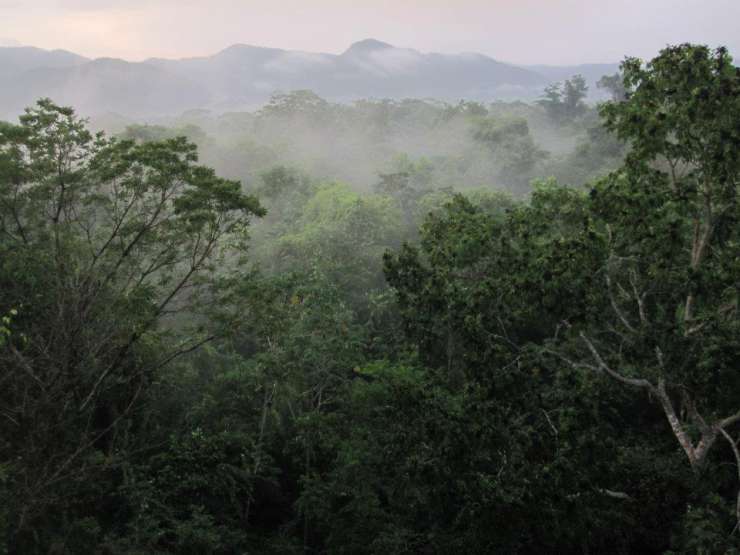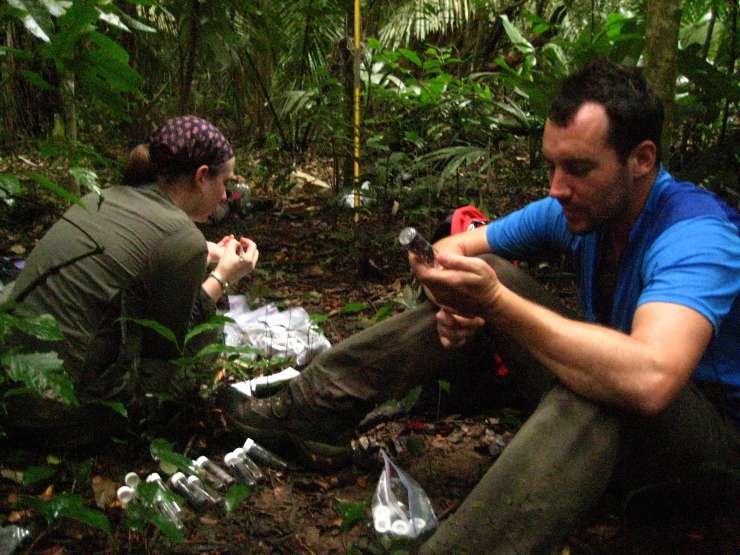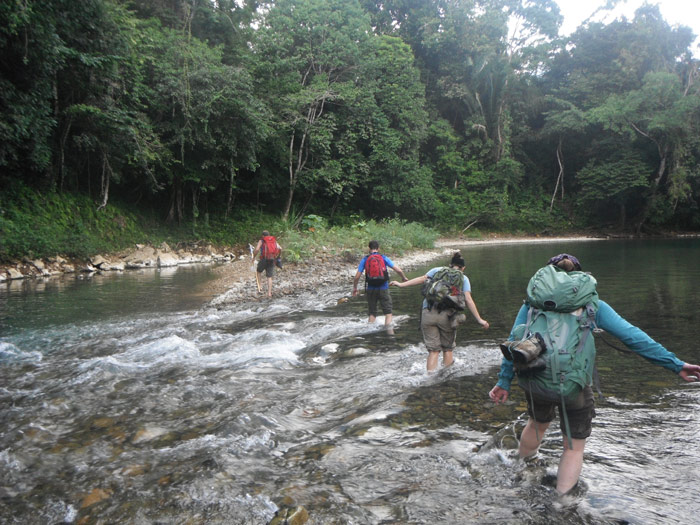
Joy B. Winbourne, Dr. Steven Brewer, and Dr. Benjamin Z. Houlton.
Background/Motivation: Tropical forests play a disproportionate role in regulating global climate; while only representing 12% of the land surface, tropical forests perform 40% of all photosynthesis on land, helping to remove carbon dioxide from the atmosphere (1). Nutrients – primarily nitrogen and phosphorus – limit plant growth and therefore the ability of forests to capture carbon via photosynthesis – especially with rising levels of atmospheric carbon dioxide due to human activity (2, 3). Understanding the factors that influence the abundance of these essential plant nutrients in tropical forests will improve our ability to predict the pace and magnitude of global climate change (4).
Ecologists have long been fascinated with the puzzling nature of nitrogen (2). Despite the fact that 80% of our atmosphere is composed of nitrogen, most ecosystems on earth are limited by this element.This limitation persists because only a select group of bacteria have the abilities to convert di-nitrogen in the atmosphere into forms that living organisms can use to produce essential amino acids and enzymes.This process, known as biological nitrogen fixation, is the most energetically expensive process performed by life on earth! It requires a huge amount of carbon and phosphorus to provide energy (6). Phosphorus, unlike nitrogen, ultimately comes from rocks.Tropical forests are extremely old ecosystems and thus much of the phosphorus has been weathered out of the soils.In addition, phosphorus can become bound to the soil and made no longer biologically available (7). In addition to phosphorus, nitrogen fixing bacteria also use significant amounts of iron and in some cases molybdenum and vanadium, in order to fix di-nitrogen from the atmosphere.

Project Description:Since 2012, the Houlton biogeochemistry research group has been investigating how variation in plant biodiversity, soil chemistry, and rock type influence the availability of nitrogen and phosphorus in tropical forests. We have been conducting this work in the Bladen Nature Reserve in southern Belize. This 100,000 acre reserve represents the greatest expanse of intact tropical rainforests and the greatest diversity of plant species in all of Central America (5). Within the reserve there is significant variation in soil chemistry and geology with forests growing on limestone or rhyolitic volcanic geologies. In addition to exploring the influence of variation in geology on chemistry of tropical forests, we have been investigating what elements limit the process of biological nitrogen fixation, a process responsible for new nitrogen to enter ecosystems.
Findings:At our study site we have found that forests growing on limestone geology have a significantly higher concentration of phosphorus in the soil and leaves of plants compared to forests growing on volcanic geology. These differences in phosphorus positively correlate with total nitrogen in the soils and rates of biological nitrogen fixation in decomposing leaves on the forest floor.Rates of N fixation in decomposing leaf litter are 3 times greater at the limestone site than at the volcanic site. These results suggest strong interactions between the phosphorus and nitrogen cycles in these tropical forests, ultimately influencing the ability of these systems to photosynthesize and capture atmospheric carbon.

Furthermore, we have observed for the first time in an unmanaged tropical rainforest that iron limits the process of biological nitrogen fixation in decomposing leaf litter in forests growing on limestone geology. The availability of iron is very low in limestone forests, owing to the strong complexation of iron under high pH conditions.These findings raise new questions regarding the role of iron in the tropical N cycle.
1.A. R. Townsend, G. P. Asner, C. C. Cleveland, The biogeochemical heterogeneity of tropical forests.Trends in Ecology & Evolution23, 424–431 (2008).
2.P. M. Vitousek, R. W. Howarth, Nitrogen Limitation on Land and in the Sea: How Can It Occur?,Biogeochemistry1–30 (2007).
3.Y. Luoet al., Progressive nitrogen limitation of ecosystem responses to rising atmospheric carbon dioxide.BioScience54, 731–739 (2004).
4.Y.-P. Wang, B. Z. Houlton, Nitrogen constraints on terrestrial carbon uptake: Implications for the global carbon-climate feedback.Geophys. Res. Lett.36, L24403 (2009).
5.S. W. Brewer, M. A. H. Webb, A seasonal evergreen forest in Belize: unusually high tree species richness for northern Central America.Botanical Journal of the Linnean Society138, 275–296 (2002).
6.J. Raymond, The Natural History of Nitrogen Fixation.Molecular Biology and Evolution21, 541–554 (2003).
7.T. W. Walker, J. K. Syers, The fate of phosphorus during pedogenesis.Geoderma15, 1–19 (1976).

